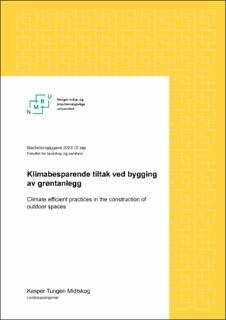| dc.contributor.advisor | Hovind, Jorun | |
| dc.contributor.author | Midtskog, Kasper Tungen | |
| dc.coverage.spatial | Norway | en_US |
| dc.date.accessioned | 2023-08-25T10:53:39Z | |
| dc.date.available | 2023-08-25T10:53:39Z | |
| dc.date.issued | 2023 | |
| dc.identifier.uri | https://hdl.handle.net/11250/3085784 | |
| dc.description.abstract | Bygg- og anleggsbransjen er ansvarlig for betydelige utslipp, direkte gjennom bruk av fossile drivstoff og indirekte gjennom produksjon og transport av materialer. Det er derfor viktig at også denne bransjen bidrar for å redusere sine utslipp i kampen mot global oppvarming.
I oppgaven undersøkes det hvordan tre ulike tiltak kan bidra til å redusere CO2-utslipp ved bygging av et grøntanlegg. De tre ulike tiltakene er: Bruk av elektriske anleggsmaskiner, bruk av norsk naturstein og gjenbruk av masser. For å vurdere kostnadseffektiviteten av de ulike tiltakene, har jeg utført en casestudie som inkluderer en forenklet kost-nytteanalyse. Studien tar utgangspunkt i et tidligere gjennomført prosjekt i Olav Vs gate i Oslo.
Gjennomføring av klimatiltak kan føre til betydelige merkostnader. Det er derfor viktig å finne tiltak som effektivt kan bidra til å redusere utslipp ved minimal forbruk av ressurser. Beregninger utført i oppgaven viser at bruk av norsk naturstein kan være nesten 6 ganger mer kostnadseffektivt enn bruk av elektriske anleggsmaskiner for å redusere CO2-utslipp. I tillegg til å være utslippsbesparende viste det seg at gjenbruk av masser også kan bidra til å redusere kostnader i et anleggsprosjekt, i motsetning til de andre tiltakene, som medførte ekstrakostnader ved gjennomføring. Det er derfor et tankekors at elektriske anleggsmaskiner har fått betydelig større oppmerksomhet i forbindelse med offentlige anskaffelser sammenlignet med de to andre tiltakene. | en_US |
| dc.description.abstract | The construction industry is responsible for significant emissions, directly through the use of fossil fuels and indirectly through the production and transport of materials. It is therefore important that this industry contributes to reducing its emissions in the battle against global warming.
The thesis examines how three different measures can contribute to reducing CO2 emissions when building an outdoor space. The three different measures are: Use of electric construction machinery, use of Norwegian natural stone and reuse of aggregates. To assess the costeffectiveness of the various measures, I have conducted a case study which includes a simplified cost-benefit analysis. The study is based on a previously completed project in Olav Vs gate in Oslo.
Implementation of climate measures can lead to significant additional costs. It is therefore important to find measures that can effectively contribute to reducing emissions with minimal consumption of resources. Calculations in the thesis show that the use of Norwegian natural stone can be almost 6 times more cost-effective than the use of electric construction machinery to reduce CO2 emissions. In addition to being emission-saving, it turned out that the reuse of aggregates can also help to reduce costs in a construction project, in contrast to the other measures, which entailed additional costs during implementation. It is therefore surprising that electrical construction machinery has received considerably more attention in connection with public procurement compared to the other two measures. | en_US |
| dc.language.iso | nob | en_US |
| dc.publisher | Norwegian University of Life Sciences, Ås | en_US |
| dc.rights | Attribution-NonCommercial-NoDerivatives 4.0 Internasjonal | * |
| dc.rights.uri | http://creativecommons.org/licenses/by-nc-nd/4.0/deed.no | * |
| dc.title | Klimabesparende tiltak ved bygging av grøntanlegg | en_US |
| dc.title.alternative | Climate efficient practices in the construction of outdoor spaces | en_US |
| dc.type | Bachelor thesis | en_US |
| dc.description.localcode | B-LI | en_US |

